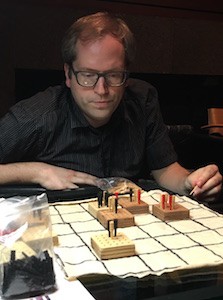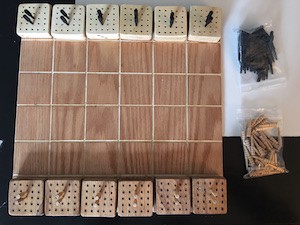I missed/skipped a day again this week, only the third time this whole project, I believe. I did three (shorter) entries 5/30 to make up for it. My enthusiasm for the project was pretty low last week. Not necessarily the idea of it, (I’m committed through at least the end of the year!), but enthusiasm for actually sitting down and doing it. It’s definitely natural to loose enthusiasm for any long-term project, or at least I expected it. I find (as with most creative endeavors in my experience) it does help for me to get away from my desk and be someplace different while I’m brainstorming. Ironically, the day I missed was (again) a day I was traveling.
5/27 – Missed a day.
5/28 – I was playing Factory Idle, and the same developer’s older game, Reactor Idle, and this idea was essentially to bring the gameplay from Factory Idle (which is apparently pretty similar to Factorio, but I haven’t played), to VR. You would connect different components with tubes, and then watch resources flow from one component to the next, but you end up with physical building blocks that you can stack in VR. And later, you might find there’s a use for them, so you have to feed them to a new machine, or stack them on top of something that will use them in some different way. Much of the game would be organizing and storing the blocks you’ve created.
5/29 – In this, you have a map and a magnifying glass. Each location on the map can be zoomed in on to see a scene (photo) that can in turn can also be magnified. But in the photos, a puppy might be made out of wooden sticks and a concrete sidewalk is made out of cathedrals and ancient roman pillars. Everything has things that it is made out of, repeating every-day objects, and later in the game, which things and where they are located is important in some way. Maybe there are dialogue mechanics too and you have to answer riddles about what things are made out of.
5/30 – You wake up only to find out your parents switched your gender while you were asleep the night before. You have to figure out what prompted them to make this change, as well as decide if you want to stay this way or go back to the way you used to be. Maybe this is a point and click adventure game, but there are character creation screens at the beginning, only after you’ve picked your gender you find out you used to be the other way (or maybe the opposite, your gender choice turns out to be who you were before the night before). Either way, gender is presented as fluid (and a choice) in this future-set teen drama. You can play the game with either gender from the beginning and ultimately decide to stay or switch back based on your choices and story decisions.
5/30 – Second entry: A game set on a space ship filled with an alien zoo. There is a room full of pedestals, with a different animal on each one, specimens from each of earth’s species preserved in stasis. Maybe you are one of them, and wake up unexpectedly. You have to explore and find your way back to earth.
5/30 – Third entry: A worker placement board game with mechanics like the factory/machine games I’ve been playing: essentially buying components to place on your board that produce resources and convert them to other (more valuable) resources. Turn-based video game variant: You only “win” when you are an order of magnitude more productive than your opponent, so two very close players might play for a very long time.
5/31 – Just some thoughts on a Game of Thrones RTS. Different races to play: White Walkers (Protos-like, VERY powerful, lots of cheap minions though, when you cast the spell to raise your enemy’s dead). Daenerys Targaryen’s Army (horsemen and dragons and unsullied), House Stark (dire wolves and powers that let you take over enemy units (warging), ultimately pretty pathetic, sorta like humans in Starcraft). It remains to be seen whether it’s worth separating out the other human GoT “houses” as playable races, maybe the class/race should just be “human”. (Note that it would still not include Daenerys.) Maybe the Children of the Forest could have a few levels toward the end of some campaign.
6/1 – Thought of this one in the shower, later, before writing it down, I realized the original idea was a bit like Journey in VR (which would of course also be super cool). The only really unique mechanic was that instead of teleporting, you can only move “one playspace away”, and you see your character roll or jump to that location. There might also be a cooldown during which you have to recover from that exercise. Initially I imagined you shooting at other players, but then I was imagining you helping them out, getting to floor switches so they could open different puzzle/exploration elements, and vice versa. There was definitely also a Tarzan / jungle theme in what I was imagining in the shower.
6/2 – More thoughts on my VR game idea from 5/15. I had forgotten about the holding two hands out to show the hoop between them, and was thinking you’d have two hoops, one for each hand, and you would be able to manipulate the size of the hoop with the trackpad. I was also thinking about perspective, and how it might be interesting to look down on the player as you manipulate the hoops, so you are almost more of a puppet master. I didn’t explore this (yet), but a VR puppet show simulator might be kind of cool.

 This week I managed to spend some time playtesting the board game idea I’d come up with (and been rather cagy about) from 3/28 and 3/30. (Pictured here is
This week I managed to spend some time playtesting the board game idea I’d come up with (and been rather cagy about) from 3/28 and 3/30. (Pictured here is  4/25 – So after making the prototype I mentioned above, I didn’t actually have a chance to play it with anyone right away. It sat on my counter for a while setup as shown in this picture. I spent more time thinking about it and as a result, had this thought: what if it’s actually more of a game system rather than a single game? Right away I came up with two new game ideas. The first is one where each piece starts with a specific number of pegs, say one in each direction, and when it moves that way the peg is removed. In this way, the piece can only move each direction once per game. There are captures, and the player who runs out of moves first loses the game. The second game is a sort of physical version of
4/25 – So after making the prototype I mentioned above, I didn’t actually have a chance to play it with anyone right away. It sat on my counter for a while setup as shown in this picture. I spent more time thinking about it and as a result, had this thought: what if it’s actually more of a game system rather than a single game? Right away I came up with two new game ideas. The first is one where each piece starts with a specific number of pegs, say one in each direction, and when it moves that way the peg is removed. In this way, the piece can only move each direction once per game. There are captures, and the player who runs out of moves first loses the game. The second game is a sort of physical version of